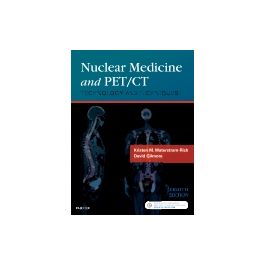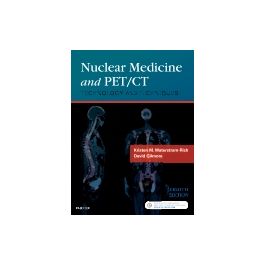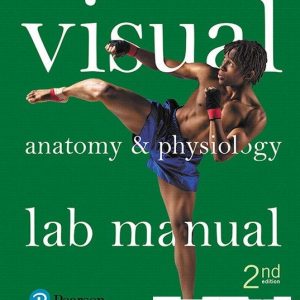Instant download Test Bank for Nuclear Medicine and PET CT 8th Edition by Waterstram Rich pdf docx epub after payment.

Product details:
- ISBN-10 : 0323356222
- ISBN-13 : 978-0323356220
- Author:
Master the latest imaging procedures and technologies in Nuclear Medicine! Medicine and PET/CT: Technology and Techniques, 8th Edition provides comprehensive, state-of-the-art information on all aspects of nuclear medicine. Coverage of body systems includes anatomy and physiology along with details on how to perform and interpret related diagnostic procedures. The leading technologies ― SPECT, PET, CT, MRI, and PET/CT ― are presented, and radiation safety and patient care are emphasized. Edited bynuclear imaging and PET/CT educator Kristen M. Waterstram-Rich and written by a team of expert contributors, this reference features new information on conducting research and managing clinical trials.
Table Of Contents:
- 1. Mathematics and Statistics
- Fundamentals
- Practical Applications
- Statistics
- Summary
- 2. Cell and Molecular Biology
- Eukaryotic Cell Structure
- Control of Gene Expression
- The Cell Cycle
- Molecular Basis of Cancer
- Summary
- 3. General Chemistry and Biochemistry
- Elements, Compounds, and Mixtures
- Laws of Constant Composition and Multiple Proportion
- Atomic Weights, Molecular Weights, and the Mole Concept
- Solutions and Colloids
- Chemical Reactions and Equations
- Acids and Bases
- Equilibriums and Equilibrium Constant
- The pH Concept
- Buffer Solutions
- Organic Compounds
- Summary
- 4. Radiochemistry and Radiopharmacology
- Production of Radionuclides
- Technetium Radiopharmaceuticals
- Gallium and Indium Radiopharmaceuticals
- Thallium Chloride
- Iodinated Radiopharmaceuticals
- PET Radiopharmaceuticals
- Therapeutic Radiopharmaceuticals
- Regulatory Issues: Radiopharmaceutical Quality Assurance
- Radiopharmaceutical Quality Control
- Summary
- 5. Radiation Safety in Nuclear Medicine
- Radiation Safety Program
- Sources of Radiation Exposure
- Radiation Regulations
- Radiation Dose
- Biological Effects of Ionizing Radiation
- Summary
- Section 2. Patient Care, Management, and Research
- 6. Patient Care
- Patient Care
- Patient Preparation
- Patient-Centered Care
- Age-Specific Care
- Pediatric Considerations
- Body Mechanics
- Medication Administration
- Contrast Media
- Infection Control
- Vital Signs and Patient Assessment
- Emergency Care
- Ancillary Equipment
- Summary
- 7. Department Administration
- Health Care Leadership
- Health Care Management
- Coding and Reimbursement
- Quality Measures and Improvement
- Credentials and Accreditation
- Summary
- 8. Clinical Research
- Defining Clinical Research
- Clinical Trials and Studies
- Conclusion
- Summary
- 9. Health Informatics in Imaging
- Background
- Computers in Health Care
- Computer Hardware
- Computer Software
- Image Acquisition
- Image Display and Processing
- Region of Interest
- Clinical Applications
- Health Information Systems
- Electronic Health Records
- Radiology Information System
- Standard Operating Procedures
- Future Advances
- Section 3. Physics and Instrumentation
- 10. Physics of Nuclear Medicine
- Matter
- Nucleus of an Atom
- Nature of Electromagnetic Radiation
- Mass Energy Equivalence
- Units
- Modes of Radioactive Decay
- Mathematics of Decay
- Units of Radioactivity
- Decay Factor and Precalibration Factor
- Effective Half-Life
- Parent-Daughter Radionuclide Relationships
- Interaction with Matter
- Attenuation and Transmission of Photons
- Summary
- 11. Instrumentation
- Radiation Detection
- Gas-Filled Detectors
- Gas Ionization Curve
- Survey Meters
- Dose Calibrator
- Dose Calibrator Quality Control
- Scintillation Detectors
- Gamma Cameras
- Gamma Camera Detector Components
- Spectroscopy
- Gamma Camera Corrections
- Image Acquisition
- Single Photon Emission Computed Tomography
- Image Quality
- Gamma Camera Quality Control
- Scintillation Counting Systems
- Summary
- 12. CT Physics and Instrumentation
- Physics of X-Rays
- X-Ray Tube and the Production of X-Rays
- Principles of Computed Tomography
- CT Scanner Design
- Multislice Helical CT Systems
- Image Data Acquisition
- CT Image Reconstruction
- CT Display
- Display of Volumetric Image Data
- Image Quality
- CT Protocols
- CT Artifacts
- CT Radiation Safety
- CT Quality Control
- Summary
- 13. PET Instrumentation
- Physics of Positrons
- Production of PET Radiotracers
- PET Radiation Detectors
- PET Scanner Design
- Coincidence Detection: True, Scatter, and Random Events
- Data Acquisition
- Two- and Three-Dimensional Scanner Configuration
- PET/CT Scanners
- Reconstruction Algorithms
- Attenuation Correction by Transmission Imaging
- Time of Flight PET
- Scanner Calibration and Quality Control
- Partial Volume Effect
- Quantitative Image Information
- Displaying PET Data
- Image Fusion
- PET/MRI Scanners
- Radiation Safety in PET
- Requirements for Gating and Radiation Therapy Treatment Planning
- Summary
- 14. Principles of Magnetic Resonance Imaging
- History
- Introduction to Atomic Structure and Basic Principles
- Hydrogen Nucleus
- Precession
- Resonance and Excitation
- Free Induction Decay
- T1 and T2
- Instrumentation
- Pulse Sequences and Scan Parameters
- Contrast Media
- Safety
- Hybrid Imaging: PET/MRI
- Summary
- 15. Clinical PET/CT in Oncology
- Intracellular 18F-FDG Metabolism
- Patient Preparation and Injection
- PET Scan Acquisition
- Normal Whole-Body FDG Distribution
- Normal Variations in FDG Localization
- PET Oncology Applications
- Solitary Pulmonary Nodule
- Non–Small-Cell Lung Carcinoma
- Other Chest Malignancies
- Melanoma
- Lymphoma
- Myeloma
- Colorectal Cancer
- Head and Neck Cancer
- Esophageal Cancer
- Breast Cancer
- Brain Cancer
- Prostate Cancer
- Cervical Cancer
- Ovarian Cancer
- Testicular Cancer
- Thyroid Cancer
- Pancreatic Cancer
- Gastric Cancer
- Hepatocellular Carcinoma
- Endometrial Cancer
- Sarcomas
- Leukemia
- Unknown Primary
- Future Trends
- Summary
- Section 4. Imaging Procedures and Protocols
- 16. Central Nervous System
- Chemistry of the Brain
- Anatomy and Physiology
- Radiopharmaceuticals
- Imaging Techniques and Protocols
- Clinical PET and Spect Studies
- Summary
- 17. Endocrine System
- Thyroid Gland
- Parathyroid Glands
- Neuroendocrine System
- Adrenal Glands
- Summary
- 18. Respiratory System
- Normal Anatomy and Physiology
- Pathophysiology
- Perfusion Imaging
- Ventilation-Perfusion Studies
- Summary
- 19. Cardiovascular System
- Anatomy, Physiology, Pathology
- Myocardial Perfusion Imaging
- Positron Emission Tomography of the Heart
- Radionuclide Evaluation of Ventricular Function
- Imaging Cardiac Neurotransmission
- Summary
- 20. Gastrointestinal System
- Salivary Glands
- Oropharynx
- Esophagus
- Stomach
- Small Bowel and Colon
- Intestinal Tract
- Liver and Spleen
- Gallbladder
- Breath Testing with 14C-Labeled Compounds
- Summary
- 21. Genitourinary System
- Anatomy
- Physiology
- Radiopharmaceuticals
- Radionuclide Procedures
- Testicular Imaging
- Measurement of Effective Renal Plasma Flow and the Glomerular Filtration Rate
- Summary
- 22. Skeletal System
- Composition of Bone
- Gross Structure of Bone
- Joints
- Radionuclide Imaging
- Instrumentation
- Spot Views
- Whole-Body Imaging
- SPECT Imaging
- Clinical Aspects
- Other Uses for Bone Imaging
- Summary
- Section 5. Special Considerations
- 23. Inflammatory/Tumor/Oncology Imaging and Therapy
- Inflammatory Imaging
- Tumor Imaging
- Lymphoscintigraphy
- Therapy
- Summary
- 24. Hematopoietic System
- Blood
- Blood Components
- Isotopic Labeling of Cellular Elements
- Platelet Kinetics
- Erythrokinetics
- Measurement of Absorption and Serum Levels of Essential Nutrients
- Summary
- Appendix A. Percentage Points and Chi-Square Distribution
- Appendix B. Laboratory Glassware and Instrumentation
- Appendix C. Radionuclides and Radiopharmaceutical Form Used in Clinical Nuclear Medicine (Includes Research Radiopharmaceuticals)
- Appendix D. Glossary
- Appendix E. Answers to Chapter 1 Mathematics and Statistics Review
- Illustration Credits
- Index
- Color Plates





